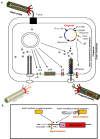Exploring the Secretomes of Microbes and Microbial Communities Using Filamentous Phage Display
- PMID: 27092113
- PMCID: PMC4823517
- DOI: 10.3389/fmicb.2016.00429
Exploring the Secretomes of Microbes and Microbial Communities Using Filamentous Phage Display
Erratum in
-
Corrigendum: Exploring the Secretomes of Microbes and Microbial Communities Using Filamentous Phage Display.Front Microbiol. 2016 Jun 14;7:927. doi: 10.3389/fmicb.2016.00927. eCollection 2016. Front Microbiol. 2016. PMID: 27379057 Free PMC article.
Abstract
Microbial surface and secreted proteins (the secretome) contain a large number of proteins that interact with other microbes, host and/or environment. These proteins are exported by the coordinated activities of the protein secretion machinery present in the cell. A group of bacteriophage, called filamentous phage, have the ability to hijack bacterial protein secretion machinery in order to amplify and assemble via a secretion-like process. This ability has been harnessed in the use of filamentous phage of Escherichia coli in biotechnology applications, including screening large libraries of variants for binding to "bait" of interest, from tissues in vivo to pure proteins or even inorganic substrates. In this review we discuss the roles of secretome proteins in pathogenic and non-pathogenic bacteria and corresponding secretion pathways. We describe the basics of phage display technology and its variants applied to discovery of bacterial proteins that are implicated in colonization of host tissues and pathogenesis, as well as vaccine candidates through filamentous phage display library screening. Secretome selection aided by next-generation sequence analysis was successfully applied for selective display of the secretome at a microbial community scale, the latter revealing the richness of secretome functions of interest and surprising versatility in filamentous phage display of secretome proteins from large number of Gram-negative as well as Gram-positive bacteria and archaea.
Keywords: adhesins; bacteriophage; metagenomics; next generation sequencing; phage display; secretome.
Figures





Similar articles
-
Corrigendum: Exploring the Secretomes of Microbes and Microbial Communities Using Filamentous Phage Display.Front Microbiol. 2016 Jun 14;7:927. doi: 10.3389/fmicb.2016.00927. eCollection 2016. Front Microbiol. 2016. PMID: 27379057 Free PMC article.
-
Metasecretome-selective phage display approach for mining the functional potential of a rumen microbial community.BMC Genomics. 2014 May 12;15(1):356. doi: 10.1186/1471-2164-15-356. BMC Genomics. 2014. PMID: 24886150 Free PMC article.
-
Filamentous Phage: Structure and Biology.Adv Exp Med Biol. 2017;1053:1-20. doi: 10.1007/978-3-319-72077-7_1. Adv Exp Med Biol. 2017. PMID: 29549632 Review.
-
Metasecretome Phage Display.Methods Mol Biol. 2018;1701:519-534. doi: 10.1007/978-1-4939-7447-4_29. Methods Mol Biol. 2018. PMID: 29116525
-
Structure, Biology, and Applications of Filamentous Bacteriophages.Cold Spring Harb Protoc. 2024 Aug 1;2024(8):pdb.over107754. doi: 10.1101/pdb.over107754. Cold Spring Harb Protoc. 2024. PMID: 37460152 Review.
Cited by
-
Akkermansia muciniphila induces mitochondrial calcium overload and α -synuclein aggregation in an enteroendocrine cell line.iScience. 2022 Feb 11;25(3):103908. doi: 10.1016/j.isci.2022.103908. eCollection 2022 Mar 18. iScience. 2022. PMID: 35243260 Free PMC article.
-
The Interspecific Fungal Hybrid Verticillium longisporum Displays Subgenome-Specific Gene Expression.mBio. 2021 Aug 31;12(4):e0149621. doi: 10.1128/mBio.01496-21. Epub 2021 Jul 20. mBio. 2021. PMID: 34281400 Free PMC article.
-
The secreted protein Amuc_1409 from Akkermansia muciniphila improves gut health through intestinal stem cell regulation.Nat Commun. 2024 Apr 6;15(1):2983. doi: 10.1038/s41467-024-47275-8. Nat Commun. 2024. PMID: 38582860 Free PMC article.
-
Whole Cell Luminescence-Based Screen for Inhibitors of the Bacterial Sec Machinery.Biochemistry. 2024 Sep 17;63(18):2344-2351. doi: 10.1021/acs.biochem.4c00264. Epub 2024 Aug 29. Biochemistry. 2024. PMID: 39207823 Free PMC article.
-
Bacterial secretion system functions: evidence of interactions and downstream implications.Microbiology (Reading). 2023 Apr;169(4):001326. doi: 10.1099/mic.0.001326. Microbiology (Reading). 2023. PMID: 37083586 Free PMC article.
References
-
- Abruquah H. H. (2009). Identification of Host-pathogen Interacting Molecules of Campylobacter Jejuni Using Phage Display Technology and In silico Sequence Analysis. Ph.D. thesis, submitted to the University of Nottingham for the degree of Doctor of Philosophy Microbiology, The University of Nottingham, Nottingham.
Publication types
LinkOut - more resources
Full Text Sources
Other Literature Sources

